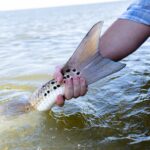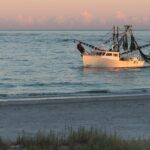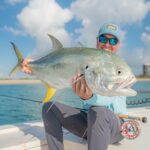
Bowfishing Banned in Biloxi Marsh
Feature Photo: Carter Abramson | Simms Fishing at the Fisheries Science Symposium We have more
The Draft Striped Bass Stock Assessment, November 2022, was released on Wednesday, October 26th. The ASGA team spent the last few days taking a hard look at the document. To set the stage, striped bass are not a data poor species. We know a great deal about striped bass. . Furthermore, the stock assessment team at the Atlantic States Marine Fisheries Commission (ASMFC) is top notch. . We were surprised by the numbers, but in a good way. That doesn’t happen very often. The assessment will be reviewed and, hopefully, adopted at the ASMFC’s Annual Meeting next week, November 7th.
Here’s our take on the current condition of the striped bass stock.
Striped Bass Status
Striped bass are no longer experiencing overfishing. That means that the fishing mortality rate, (F), is at an acceptable rate and below both the threshold and target reference points. We were killing less fish in 2021.

Yet, striped bass are still overfished, meaning female biomass (SSB) remains below the threshold reference point (the red line in the chart below).

Projections from Stock Assessment
“It’s tough to make predictions, especially about the future.” Yogi Berra
According to the stock assessment, striped bass have a 78.65% chance of being above the target by 2029 if the catch mortality rate does not increase The industry standard is only a 50% chance. We are in pretty good shape in that regard.
It is a Long Way to 2029
The news has been good so far. The stock is not experiencing overfishing anymore. There is a better than average shot that SSB will be recovered to target by 2029. But, what happens between now and 2029? Heck, what happens after the upcoming meeting? Well, that is where we remain somewhat worried, because that is where the uncertainty lies, especially the further you project into the future. Fortunately, ASMFC will be conducting several new assessments between 2023 and 2029, so we will be able to react if the stock starts to exhibit warning signs and decreases the chances of rebuilding by 2029.
Here are the things we don’t have to worry about. First, there is no more Conservation Equivalency. That means everyone in the ocean will have the same regulations. Likewise, the Chesapeake Bay jurisdictions will have to all agree on their regulations. That also means that the bay “trophy season” will have to follow whatever the ocean regulations are. If you recall, Maryland was one of the few states that allowed recreational harvest of fish over 35”. They won’t be able to do that anymore.
Speaking of the slot limit, we don’t think that will change. According to the assessment’s fishing mortality estimates, the slot limit is working. There won’t be much of an appetite to try something new at the November meeting. So, no need to worry about the slot limit being removed.
In other words, y’all did one hell of a job advocating for striped bass. Seriously, we aren’t prone to throwing around ‘atta’ boys’ with reckless abandon. The striped bass community rallied around saving this iconic fish. You all did your homework, never gave up, moved the needle at the ASMFC, and learned an awful lot in the process. Digital high fives to every single one of you.
So, what are we worried about and what should you be on the lookout for in the near future?
That 78.6% chance of rebuilding the stock by 2029 is based on an assumption that fishing mortality will remain at 0.14, which is very low.

So, what happens to fishing effort and the stock when the 2015, 2017, and 2018 year classes are fully recruited to the SSB and hit the slot limit? Those are the last three good years classes we have. Will more fish equate to more pressure? That would mean a jump in F. History has taught us over and over that effort is extremely hard to predict. When more fish are in the water, more people go fishing more often. We can’t rely on F remaining under the target (F=0.17).
If F increases to the threshold (F=0.20), we have less than a 50% chance of reaching the target SSB in any year. If the history of the striped bass fishery and its management has told us anything it’s this: when there are more fish out there, more people go fishing. How effort and F might change with increasing availability of slot-sized fish is something we need to watch very carefully.
We also need to continue to monitor the Juvenile Abundance Index (JAI). While Maryland continues to have below average spawns, Virginia and New York seem to be carrying the load with at least average spawns the last few years. We have not seen New York’s numbers for 2022, but Virginia came in slightly above average. We are worried about what will happen after 2029; we might successfully rebuild the stock and then see the bottom fall out due to continued poor recruitment from the historically largest producer area.
This is Far from Over
We aren’t going to sit on the sidelines and hope for the best. Between now and 2029, there will be two updates to the assessment and then another benchmark assessment in 2029. That will give us ample opportunity to monitor the progress for rebuilding the striped bass stock. At any point along the way, we will be able to adjust regulations to help lower F if needed.
We are not in a terrible position. It is not nearly as bad as any of us would have guessed. Yes, we trust the data from the stock assessment. ASGA was built on the premise that fisheries have to be managed using the best science as a guide. Well, this is by far the best science we have for stripers. It would be hypocritical for us to not be supportive.
Do we worry about low JAI, increases in effort, and year classes that have to work through the slot? Heck yes, we do. It keeps us up at night.
If we had to sum it up, we would simply say that we are on the right track for now and we plan to do everything in our power to stay on that track. It’s a long way to 2029, and we will be here for you fighting for these fish until then.
Congratulations to all of you who wrote letters, spoke to friends, educated yourselves on the issues, and generally gave a damn. You did it. We can win these fights. You made a difference. Thank you all, from the bottom of our hearts.

Feature Photo: Carter Abramson | Simms Fishing at the Fisheries Science Symposium We have more

Each year, hundreds of millions of fish are killed as collateral damage from large-scale, inshore

Feature Photo Credit: Scientific Anglers Team At the heart of the Jack Project is a

Header Photo: Camden Spear Over the past several years, ASGA has consistently championed science-based, precautionary
We rely on our members and donations to keep fighting for a sustainable tomorrow in marine conservation.
GIVE THE GIFT OF FISHERIES CONSERVATION THIS HOLIDAY SEASON. SHOP ASGA GOODS THAT FUND FISHERIES RESEARCH & ADVOCACY CAMPAIGNS
JOIN ASGA IN CALLING FOR CRITICAL MANAGEMENT ACTION AFTER YEARS OF SPAWN FAILURES & POOR MANAGEMENT.
By using this website, you agree to our use of cookies. We use cookies to provide you with a great experience and to help our website run effectively. To learn more, please review our privacy policy.
3 Responses
This is good information for all those interested in a sustainable Striped Bass Fishery. Thanks to the ASGA for their vigilance and action on behalf of the
Striper fishery .